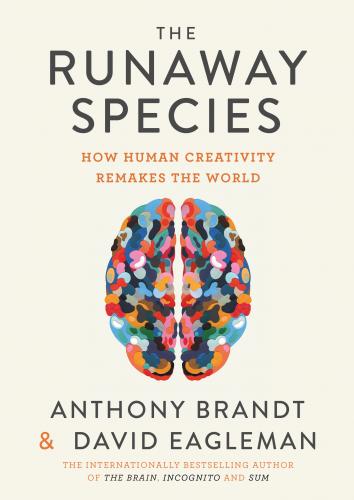The Runaway Species
How Human Creativity Remakes the World
Anthony Brandt and David Eagleman
Published in Great Britain in 2017 by Canongate Books Ltd,
14 High Street, Edinburgh EH1 1TE
This digital edition first published in 2017 by Canongate Books
Copyright © Anthony Brandt, 2017
Copyright © David Eagleman, 2017
Extract from ‘The Lovesong of J. Alfred Prufrock’ by T S Eliot reprinted by kind permission of Faber & Faber. © Set Copyrights, 2015
Extract from ‘Complete Poems: 1904-1962’ reprinted by kind permission of Liveright Publishing Corporation. © 1950, 1978, 1991 by the Trustees for the E. E. Cummings Trust, from COMPLETE POEMS: 1904-1962 by E. E. Cummings, edited by George J. Firmage.
The moral right of the author has been asserted
While every effort has been made to trace the owners of copyright material produced herein, the publishers would like to apologise for any omissions and will be pleased to incorporate missing acknowledgements in any further editions.
British Library Cataloguing-in-Publication Data
A catalogue record for this book is available on request from the British Library
ISBN 978 0 85786 206 8
Export ISBN 978 0 85786 2 075
eISBN 978 0 85786 2 099
To our parents, who brought us into a life of creativity
Nat & YannaCirel & Arthur
our wives, who fill our lives with novelty
KarolSarah
and our children, whose imaginations summon the future
Sonya, Gabe, LucianAri and Aviva
CONTENTS
Introduction: What do NASA and Picasso have in common?
2. The brain alters what it already knows
Part II: The Creative Mentality
9. Scout to different distances
Part III: Cultivating Creativity
INTRODUCTION
WHAT DO NASA AND PICASSO HAVE IN COMMON?
Several hundred people scramble in a control room in Houston, trying to save three humans ensnared in outer space. It’s 1970 and Apollo 13 is two days into its moonshot when its oxygen tank explodes, spewing debris into space and crippling the craft. Astronaut Jack Swigert, with the understatement of a military man, radios Mission Control. “Houston, we’ve had a problem.”
The astronauts are over 200,000 miles from Earth. Fuel, water, electricity and air are running out. The hopes for a solution are close to zero. But that doesn’t slow down the flight director back in NASA Mission Control, Gene Kranz. He announces to his assembled staff:
When you leave this room, you must leave believing that this crew is coming home. I don’t give a damn about the odds and I don’t give a damn that we’ve never done anything like this before … You’ve got to believe, your people have got to believe, that this crew is coming home.1
How can Mission Control make good on this promise? The engineers have rehearsed the mission down to the minute: when Apollo 13 would reach the moon’s orbit, when the lunar module would deploy, how long the astronauts would walk on the surface. Now they have to shred that playbook and start over. Mission Control had also prepared abort scenarios, but all of those assumed that the main parts of the spacecraft would be healthy and the lunar module expendable.2 Unfortunately, the opposite is now true. The service module is destroyed and the command module is venting gas and losing power. The only working part of the craft is the lunar module. NASA has simulated many possible breakdowns, but not this one.
The engineers know that they have been dealt a nearly impossible task: save three men locked in an airtight metal capsule, hurtling at 3,000 miles an hour through the vacuum of space, their life support systems failing. Advanced satellite communication systems and desktop computers are still decades away. With slide rules and pencils, the engineers have to invent a way to abandon the command module and turn the lunar module into a lifeboat bound for home.
The engineers set about addressing the problems one by one: planning a route back to Earth, steering the craft, conserving power. But conditions are deteriorating. A day and a half into the crisis, carbon dioxide reaches dangerous levels in the astronauts’ tight quarters. If nothing is done the crew is going to suffocate within a few hours. The lunar module has a filtration system, but all of its cylindrical air scrubbers have been exhausted. The only remaining option is to salvage unused canisters from the abandoned command module – but those are square. How to fit a square scrubber into a round hole?
Working from an inventory of what’s on board,
